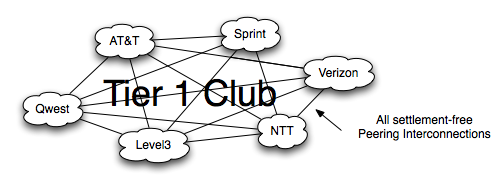Definition: A Regional Tier 1 ISP is an ISP that has access to the entire Internet Region routing table solely through Peering relationships.

The figure above models a Tier 1 ISP graphically as selling transit to downstream customers, peering traffic away off to the side, and operating backbone links to offload the traffic elsewhere in their network.
Through these free peering connections, the Tier 1 ISPs all enjoy settlement-free access to all destinations within the Internet Region. Some in the Peering Community refer to the set of Tier 1 ISPs as the "The Tier 1 club". The Tier 1 ISPs sell access to the region as part of a transit service as well, often as a wholesale transit service, to Tier 2 ISPs, CDNs, and Large Scale Network Savvy Content Providers.

While this "Tier 1 ISP" definition has been criticized as being almost impossible to prove it is an important distinction as it pertains to ISP motivations and behaviors in the Internet Region. Tier 1 ISPs are not motivated to peer to reduce the cost of transit since, by definition, Tier 1 ISPs don’t pay for transit.
Tier 1 ISPs may peer in many geographically diverse locations for technical reasons. Peering has the benefit of lower latency, better control over routing, and may therefore lead to lower packet loss. For ISPs that charge on a per-Mbps basis, this leads to financial benefits as customers use more bandwidth and therefore pay more money. This is a function of TCP: lower latency and lower packet loss means that the TCP window opens more quickly. This results in greater usage and therefore greater customer revenue. Most Tier 1 ISPs around the world exchange enough traffic with each other to require multiple points of interconnect.
A Tier 1 Peering Policy generally includes a minimum number of locations as a requirement for peering.
Tier 1 ISPs do not need to buy transit since by definition they can reach all the networks in the Internet Peering Ecosystem solely through free peering relationships. Stated most eloquently by Waqar Khan (Qwest, a Tier 1 ISP in the U.S.), “We have all the peering we need.” It is not surprising that Tier 1 ISPs see the rest of the players in the Internet Peering Ecosystem players as potential customers, and do not seek peering with them. In fact, James Spenceley (Comindico) went through the process of negotiating peering with the Tier 1 ISPs in Australia and described the Tier 1 peering negotiation tactics in a one word acronym: MILD: Make It Long and Difficult . This reflects the ISP’s underlying Peering Inclination, perhaps articulated in their Peering Policy .
A Tier 1 ISP doesn't pay transit fees to anyone to reach any desitnation within the region, therefore tends to not have any motivation to peer with anyone else. This leads to a generally restrictive peering inclination as articulated by a restrictive peering policy.
This also leads to the inevitable "donut peering" around the Tier 1 club, where the Tier 2 ISPs, the large scale network savvy Content Providers, cable and dsl access networks, etc. peer around the Tier 1 club so as to not pay any more transit fees than absolutely necessary.